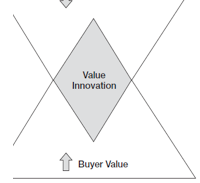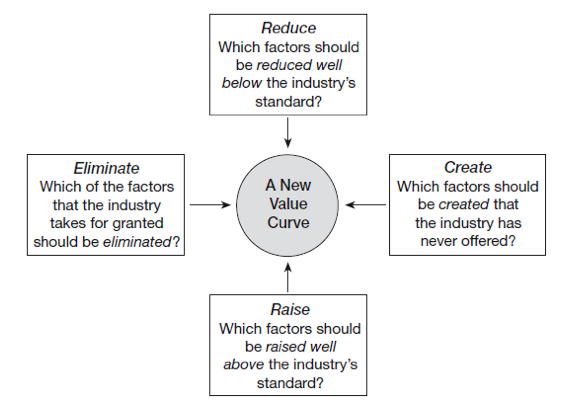In this article, we brief on what the architect of disruptive innovation Clayton Christensen explained in his seminal work called disruptive theory. This contains the edited excerpts of ‘What is disruptive innovation’ article published in Harvard Business Review. We also considered the tools, frameworks and concepts from Blue Ocean Strategy developed by W. Chan Kim and Renee Mauborgne, as we feel that the Indian companies adopt the essence of both the Disruptive Innovation and Blue Ocean Strategy ideas.
Clayton clarifies Disruption is a process where by a smaller company with fewer resources is able to successfully challenge established incumbent businesses. Specifically, as incumbents focus on improving their product and services for the most demanding customers, new entrants prove disruptive by successfully targeting those overlooked segments and by delivering more suitable functionality frequently at lower price. And any product or service to be considered as disruptive innovation must actually fit into the two important criteria below.
- Low-end footholds
- New market footholds
Low-end footholds
 Low-end footholds exist; when an established or large organization focuses only on the prime customers or most profitable customers and overlook their needs and fail to fulfil the needs of the least profitable or low-end customers. New entrants seize the white space by servicing to these low-end segments with ‘good enough’ product. The performances of the new entrants are ever improving when compared to those established incumbents. However, the quality of their offerings increases over the period of time. New entrants create unprecedented value to the customers by adopting Value Innovation. Value Innovation is created in the region where a company’s actions favourably affect both its cost structure and its value proposition to buyers.
Low-end footholds exist; when an established or large organization focuses only on the prime customers or most profitable customers and overlook their needs and fail to fulfil the needs of the least profitable or low-end customers. New entrants seize the white space by servicing to these low-end segments with ‘good enough’ product. The performances of the new entrants are ever improving when compared to those established incumbents. However, the quality of their offerings increases over the period of time. New entrants create unprecedented value to the customers by adopting Value Innovation. Value Innovation is created in the region where a company’s actions favourably affect both its cost structure and its value proposition to buyers.
Cost savings are made by eliminating and reducing the factors industry competes on and buyer value is lifted by raising and creating the elements industry has never offered. Kim and Mauborgne call it ‘4 Action Framework’ in their book titled ‘Blue Ocean Strategy, 2005.’
3nethra capturing Low-end segments through Value Innovation in India.
3nethra, eye pre-screening device, a product of Forus Healthcare, has made a significant impact in the eye care industry, in private clinics as well as in large eye hospitals. A significant contribution of 3nethra to eye care is the fast screening made possible by this device. Quick, yet accurate, screening translates into shorter waiting periods for patients. In a domino effect, quick screening also means that the eye doctor can devote more time to patients that need immediate attention. The simplicity of usage of 3nethra results in minimal training to operate the device. While, most eye pre screening devices cost between Rs 18 and 20 lakh, 3nethra costs just about Rs 5 lakh. 3nethra is also being used in community healthcare services and CSR initiatives. Forus, has conducted over 100 eye check-up camps all over India and screened over 2,50,000 people so far. Additionally, 3nethra can be installed in kiosks in places with high footfalls like airports, railway stations and even malls, where one can walk in and get fast, affordable and accurate screening for common eye diseases for their entire family.

New market footholds
In new-market footholds, disruptors get into the uncontested market place and make the competition irrelevant. They find ways to convert non-customers to customer. In Blue Ocean Strategy, Kim and Mauborgne delineate as ‘the three tiers of non customers’ who can be transformed into customers.
First Tier: ‘Soon to be’ noncustomers who are on the edge of your market. They minimally use current market offerings to get by as they search for something better. Upon finding better alternative they will jump ship.
Second Tier: ‘Refusing’ noncustomers who consciously choose against your market because they find the offerings unacceptable or beyond their means.
Third Tier: ‘Unexplored’ noncustomers who are in markets distant from yours. They are the ones who have not been targeted or thought as potential customers by any existing incumbents.
Harboring these noncustomers is an ocean of untapped demand waiting to be released.
Paytm transforming noncustomers to customers
 Digital wallet and mobile commerce marketplace Paytm is creating huge market by enabling more than 80,000 merchants to do the transactions on its platform. Paytm is an Indian e-commerce shopping website launched in 2010, owned by One97 Communications which initially focused on Mobile and DTH Recharging. The company is headquartered in Noida, India. It gradually provided recharging and bill payment of various portals including electricity bills, gas bills, as well as telephone bills. Paytm entered India’s e-commerce market in 2014, providing facilities and products similar to businesses such as Flipkart, Amazon.com, Snapdeal. In 2015, it added booking bus travel. In July 2015, it included industrial supplies such as power tools, safety and security equipment, test & measurement apparatuses, machines, lab supplies, abrasives etc on its platform. Paytm states that the initiative will help SMEs get in touch with different suppliers for different needs. Currently, it claims to have crossed over 100 million users in the country in a very short span. It also declares that more than 75 million transactions are made through their platform. In 2014, the company launched Paytm Wallet, India’s largest mobile payment service platform with over 40 million wallets. The service became the preferred mode of payment across leading consumer internet companies such as Uber, BookMyShow, MakeMyTrip and many more.
Digital wallet and mobile commerce marketplace Paytm is creating huge market by enabling more than 80,000 merchants to do the transactions on its platform. Paytm is an Indian e-commerce shopping website launched in 2010, owned by One97 Communications which initially focused on Mobile and DTH Recharging. The company is headquartered in Noida, India. It gradually provided recharging and bill payment of various portals including electricity bills, gas bills, as well as telephone bills. Paytm entered India’s e-commerce market in 2014, providing facilities and products similar to businesses such as Flipkart, Amazon.com, Snapdeal. In 2015, it added booking bus travel. In July 2015, it included industrial supplies such as power tools, safety and security equipment, test & measurement apparatuses, machines, lab supplies, abrasives etc on its platform. Paytm states that the initiative will help SMEs get in touch with different suppliers for different needs. Currently, it claims to have crossed over 100 million users in the country in a very short span. It also declares that more than 75 million transactions are made through their platform. In 2014, the company launched Paytm Wallet, India’s largest mobile payment service platform with over 40 million wallets. The service became the preferred mode of payment across leading consumer internet companies such as Uber, BookMyShow, MakeMyTrip and many more.
Bibliography
- What is disruptive innovation by Clayton Christensen, http://hbr.org/2015/12/what-is-disruptive-innovation
- Book titled Blue Ocean Strategy, 2005, by W Chan Kim and Renee Mauborgne
- Forushealth.com, http://forushealth.com/forus/Implementation.html
Paytm, https://en.wikipedia.org/wiki/Paytm
This writeup is complied and created by R Ragavendra Prasath; volunteer for iSPIRT.
Disclaimer
Disruptive Innovation and Blue Ocean strategy are two distinctive thinking by itself and broad as it is deep. Adopted these thinking together for learning and understanding purposes only.

